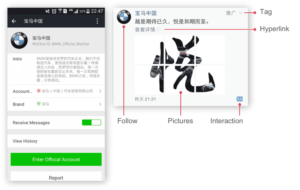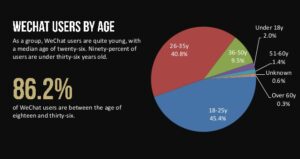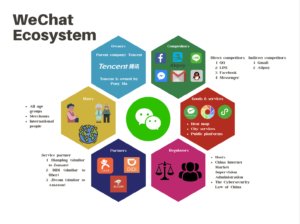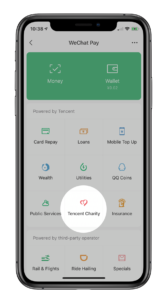
In the era of mobile Internet, it is necessary to “choose the right innovation at the right time” to make a success (Zhu, 2018, p.33). As a brand-new mobile social network platform, WeChat has not only changed the way people communicate but also initiate changes in the media industry. This essay will begin with the birth and development of and discuss its transformative effect, business model and internet ecosystem. WeChat itself, as a channel for information dissemination, is ideally suited to cell phones as mobile network terminals and has a valuable social impact. As a phenomenal product generating profound social and economic effects, WeChat has nurtured the largest ecology in the mobile Internet (Zhu, 2018, p.33).
PART I: What is WeChat?
Open the WeChat website, you can see a text introducing it: available for all kinds of platforms; enjoy group chat; support voice, photo, video and text messages (WeChat, 2020). Tencent, the parent company of WeChat, founded in 1998, has long been dedicated to the development of the social network and introduced the first instant messenger in 1999 – QQ (Zhu, 2018, p.33). Since then, it has been very active in the Chinese Internet field for more than a decade, keeping abreast of the latest Internet product technologies, and its business line covers almost all Internet products. WeChat is one of Tencent’s many products and it has integrated social interaction, e-commerce, payment, and O2O features into one platform (Zhu, 2018, p.36).

WeChat was first launched on January 21, 2011, with the aim of providing a free application for instant messaging services that mainly use for smartphones. It offers free chat software similar to Kik. Users can instantly send voice, video, pictures and texts via their phones, tablets and web pages. It allows people to set up public platforms, share on “moments” (like a Facebook newsfeed) and send information to their followers (Zhu, 2018, p.36). Users can also add friends by shake function, searching, people nearby, and scan QR codes.
How has it come to have such a transformative effect?
1) A simple, convenient product
WeChat puts much emphasis on reverse iteration, as they are aware that a product is not welcomed for its numerous features, but for its convenience to use (Zhu, 2018, p.38). Although its function is not completely original, when WeChat puts all these functions into one, it is much richer and more intelligent in its form and content than the traditional communication method.

2) The use of QR code

Under the traditional media model, advertising is almost the entire revenue source. QR codes provide the basis for the extension of the industry chain, with users scanning QR codes for advertising and new mobile payment models. In this way, it can truly be integrated into daily life, strengthening the integration of online and offline.
3) User experiences
In the era of new media, the user is the greatest creator of value. Traditional media started to change their way of communication to its audiences, and WeChat provides them with a public platform where they can push notifications to a larger population. Massive invisible data has been collected through Wechat’s implicit social interaction with its users, therefore, by analyzing data and using algorithms, WeChat can accurately grasp the user’s needs. Thus, greatly enhances the experience of users.

WeChat is deeply connected with people’s daily lives and feelings, providing users with new communication experiences while moving towards commercialization through social networks. It is developing into a social e-commerce system (Yu et al., 2017, p.35).
PART II: WeChat’s business model
The business model concept emerged over the past two decades and it was first studied and applied with the rise of the Internet and the e-businesses (Pels, 2015, p.202). Under the specific network environment in China, the business model of WeChat can be divided into the following four parts:
- Advertising
- Value-added service fees
- Game revenue
- O2O platform
1) Advertising
Social media’s practical application has changed the way of communication between organizations and consumers (Nawaz, 2020, p.1). WeChat moments advertisement can bring positive advertising results for advertisers, for example, BMW’s news feed ads published in the WeChat moments had a total exposure of nearly 46 million within 16 hours.

2) Value-added service fees
WeChat’s value-added services fees are targeted at two groups of users, the general public and the public platform users. After WeChat 5.0 had been launched, the path to commercialization for WeChat became clearer gradually (Yu et al., 2017, p.40). The paid stickers are a way for WeChat to explore value-added service fees. However, so far it has been immature.
3) Game revenue
WeChat version 5.0 has added a new “Game Center” portal, which also marks the beginning of WeChat’s attempt to explore its own business model in the field of games. WeChat has introduced games as social elements and generates revenue through the interaction between friends playing games and life credit exchange, purchases made within games have become a source of profit for them (Yu et al., 2017, p.40).

4) O2O platforms
A positive interaction between online and offline has been creating a triple win ecological environment for O2O platforms, merchants and users. Presently, 95% of the businesses that have enabled WeChat payment have set up WeChat stores (Zhu, 2018, p.40).

WeChat’s large user scale and high user viscosity can provide the necessary online traffic guarantee for O2O projects. Since online sharing drives or leads to offline sharing (John, 2016, p.70), thus WeChat facilitates this sharing economy and allows merchants’ information to reach a wider audience.
Attempts to shut down WeChat in the US have worsened division in the Chinese-American community (Guo, 2020).
In August, President Trump issued an executive order to ban WeChat, invoking the Emergency Economic Powers Act and the National Emergencies Act (Lyons, 2020). The debate around WeChat ban has been rising both locally and internationally, especially caused an uproar in the Chinese-American community. WeChat is extremely important for Chinese-American for them to communicate with their parents, while many Chinese-Americans actually agreed that WeChat deserved more scrutiny, few believed that Trump’s ban (Guo, 2020).
In fact, WeChat groups were mostly non-political, but by the time the 2016 US presidential election took place, it captivated audiences on WeChat and caused a political divide in the community (Guo, 2020). However, all mainstream applications collect personal data in order to build big data platforms. Therefore, it is more likely a tendency of the technology industry. The only question is whether the channels for using these private personal data are ethical and whether the security guarantees are reliable and standardized.
PART III: WeChat’s internet ecosystem
New words and phrases abound in the Internet ecology, where people aren’t users, but informavores (consumers of information) (Mcfedries, 2003, p.68). WeChat quickly occupied the market after launching and at one stage ranked first among applications from 27 countries and regions (Yu et al., 2017, p.37), and it has formed a powerful Internet ecosystem since it developed from 1.0 social networking and is gradually becoming the infrastructure of the entire mobile Internet. There isn’t an obvious gender and age difference in WeChat’s user structure but was trending towards young people who have great consumption potential. Therefore, it is a suitable platform for mass marketing campaigns (Yu et al., 2017, p.39).

From a social point of view, the boundary of the WeChat ecology should not stop at social networking but has now reached the boundary of the middle platform (packaged business capability). There are millions of ecosystem apps in WeChat today (Shih, 2016), ranging from WeChat official account, wallet and mini programs have all been launched to form a complete ecosystem (Chinese Academy of Cyberspace Studies, 2019, p.89).
Sink, share, and mini program, creating new traffic bonuses.
Moreover, businesses, municipalities, celebrities, and other entities can become part of the WeChat ecosystem by creating an official account, this allows them to access APIs to build apps within WeChat, utilize WeChat Payments (Shih, 2016). WeChat already has over 17,000 partners, including DiDi, Dianping, JD.com etc. that enabled users to top up phones, buy movie tickets, lottery, and coffee through the platform (Zhu, 2018, p.41). Certainly, WeChat also has a lot of strong competitors in different areas across the world, for instances, Facebook, Alibaba, Amazon and LINE.

Regulators
The government is regulating WeChat official accounts. China takes a combination approach of routine and emergency management and a combination of management by law and prevention with technology to manage new media (Yu et al., 2017, p.74). However, for public platforms and individuals, WeChat adopts the principle of combining administrative regulation, industry self-discipline and public oversight to regulate the online communication order (Yu et al., 2017, p.74), but more relying on users to report misbehavior.

PART IV: How has WeChat revolutionized the new media?
Nowadays, the trend of mobile Internet is reaching out to every nook and corner of China’s social life, without a doubt, WeChat is the masterpiece innovation that is always reforming itself with new ideas, more efficient and effective models (Zhu, 2018, p.46). WeChat’s innovative functions not only transformed our understanding with the Internet but also changed the way people relate socially.
1) Red packets
The Internet has restructured the lifestyle of Chinese consumers (Zhu, 2018, p.45). Back to 10 years ago, it was difficult to find an online payment service that could make people feel comfortable using it. Fast forward to now, 362 cities of the country had opened online urban service to the public through the WeChat platform, benefiting over 400 million users, and covering over 50 services such as transportation, entertainment and payments (Chinese Academy of Cyberspace Studies, 2019, p.77).

More importantly, WeChat red packets have significantly changed the way people celebrate Chinese New Year. The CCTV New Year’s Gala used to be a must-see TV program on the eve of the Lunar New Year, but now it has lost its appeal. In January 2014, WeChat’s grabbing red packets became popular and over 8 million users got over 40 million red packets during the Spring Festival that year, which promoted the popularization of mobile payment APPs (Chinese Academy of Cyberspace Studies, 2019, p.58).

2) Mini programs
WeChat mini programs released in 2017, they are “sub-applications” within the WeChat ecosystem, enabling them to provide advanced features to users such as e-commerce, coupons etc. (Graziani, 2019). Mini programs received great attention in the tourism context. Meanwhile, online travel agents have launched their mini-programs to attract travel users, including Booking, C-trip, which has been growing rapidly (Chen et al., 2019, p.334). People’s life is benefited through the convenient feature of mini programs, since it doesn’t use any storage, because different services are embedded in WeChat. Similarly, businesses have also benefited, which they can rely on to generate traffic and sales through user interaction and sharing through mini programs.


Internet charity
Besides this, WeChat has also boosted Internet charity. Since 2013, thanks to WeChat and Sina Weibo and other network media platforms, the charity has been enjoying rapid spread and low cost (Chinese Academy of Cyberspace Studies, 2019, p.148). By October 2017, 470 million Internet users had donated their steps in exchange for RMB 580 million (AUD 120 million) of the charitable fund (Chinese Academy of Cyberspace Studies, 2019, p.149).
A final note
Not surprisingly, a significant portion of the changes that have occurred in the real world have come from the Internet, and the original “virtual world” has long been closely connected to everyone’s lives, almost all needs can be fulfilled through the Internet. WeChat must be seen in broader terms than “just” being social media (Montag et al., 2018, p.2), it is a whole new lifestyle for Chinese people. China’s economic growth can be said to be inseparable from WeChat, at the same time, social e-commerce has also been brought to the forefront because of the evolution of mobile payments. WeChat’s official account platform has also created a wealth of opportunities for entrepreneurship and innovation (Zhu, 2018, p.40).
References
- Cheng A., Ren G., Hong T., Nam K., Koo C. (2019) An Exploratory Analysis of Travel-Related WeChat Mini Program Usage: Affordance Theory Perspective. In: Pesonen J., Neidhardt J. (eds) Information and Communication Technologies in Tourism 2019. Springer, Cham. Retrieved from https://doi-org.ezproxy1.library.usyd.edu.au/10.1007/978-3-030-05940-8_26
- Chinese Academy of Cyberspace Studies (2019) Clean Cyberspace. In: Chinese Academy of Cyberspace Studies (eds) China Internet Development Report 2017. Springer, Berlin, Heidelberg. Retrieved from https://doi-org.ezproxy1.library.usyd.edu.au/10.1007/978-3-662-57521-5_5
- Guo, E. (2020). Censored by China, under attack in America: what’s next for WeChat?. Retrieved from https://www.technologyreview.com/2020/10/30/1011450/wechat-censored-china-under-attack-in-america/
- Graziani, T. (2019). What are WeChat Mini-Programs? A Simple Introduction. Retrieved from https://walkthechat.com/wechat-mini-programs-simple-introduction/
- John, N. A. (2016). The age of sharing. ProQuest Ebook Central Retrieved from https://ebookcentral-proquest-com.ezproxy2.library.usyd.edu.au
- Lyons, K. (2020). Judge again blocks Trump administration push to ban WeChat in the US. Retrieved from https://www.theverge.com/2020/10/23/21531154/judge-denies-trump-administration-ban-wechat-tencent-china
- Mcfedries, P. (2003). The internet ecology. IEEE Spectrum, 40(4), 68–68. Retrieved from https://ieeexplore-ieee-org.ezproxy2.library.usyd.edu.au/document/1191786
- Montag, C., Becker, B., & Gan, C. (2018). The Multipurpose Application WeChat: A Review on Recent Research. Frontiers in psychology, 9, 2247. Retrieved from https://doi.org/10.3389/fpsyg.2018.02247
- Nawaz, M. (2020). Youngsters and WMAs (WeChat Moments Advertisement): Do We Need the English Language in WMAs? SAGE Open, 10(2). Retrieved from https://journals.sagepub.com/doi/full/10.1177/2158244020922840
- Pels, J. (2015). Business model innovation. International Journal of Pharmaceutical and Healthcare Marketing, 9(3), 200–218. Retrieved from https://www-emerald-com.ezproxy2.library.usyd.edu.au/insight/content/doi/10.1108/IJPHM-02-2014-0011/full/html
- Shih, C. (2016). Mobile Messaging and Social Commerce: Going from ‘Likes’ to ‘Buys’. In: Social Business Imperative, The: Adapting Your Business Model to the Always-Connected Customer (1st edition). Addison-Wesley Professional. Retrieved from https://learning.oreilly.com/library/view/social-business-imperative/9780134263441/ch07.xhtml
- WeChat. (2020). WeChat open platform. Retrieved from https://open.weixin.qq.com/
- Yu X., Zhao T., Tong S. (2017) Development Report on China’s WeChat in 2014. In: Tang X., Wu X., Huang C., Liu R. (eds) Development Report on China’s New Media. Research Series on the Chinese Dream and China’s Development Path. Springer, Singapore. Retrieved from https://doi-org.ezproxy1.library.usyd.edu.au/10.1007/978-981-10-3683-5_4
- Zhu X. (2018) Case II: Micro Platform, Major Innovation—WeChat-Based Ecosystem of Innovation. In: China’s Technology Innovators. Management for Professionals. Springer, Singapore. Retrieved from https://doi-org.ezproxy1.library.usyd.edu.au/10.1007/978-981-10-5388-7_2



